Cambyses II › Tushpa » Ancient origins
Articles and Definitions › Contents
- Cambyses II › Who Was
- Tushpa › Antique Origins
Ancient civilizations › Historical and archaeological sites
Cambyses II › Who Was
Definition and Origins

Cambyses II (r. 530-522 BCE) was the second king of the Achaemenid Empire. The Greek historian Herodotus portrays Cambyses as a mad king who committed many acts of sacrilege during his stay in Egypt, including the slaying of the sacred Apis calf. This account, however, appears to have been derived mostly from Egyptian oral tradition and may therefore be biased. Most of the sacrileges attributed to Cambyses are not supported by contemporary sources. At the end of his reign, Cambyses faced a revolt by a man who claimed to be his brother Smerdis, and he died on his way to suppress this revolt.
KING OF BABYLON
Cambyses was born to Cyrus the Great and his wife Cassandane, a sister of the Persian nobleman Otanes. Cambyses had a younger brother named Smerdis, from the same mother and the same father. As early as 539 BCE, when Cyrus conquered Babylon, Cambyses held the position of crown prince. He is mentioned on the Cyrus Cylinder, along with his father Cyrus, as receiving blessings from the Babylonian supreme god Marduk. In Babylonian documents dating between April and December 538 BCE, Cambyses is described as 'king of Babylon', while Cyrus was given the title 'king of the lands'. Cambyses may have been appointed king of Babylon in preparation for his succession to the Persian throne.
CAMBYSES MAY HAVE BEEN APPOINTED KING OF BABYLON IN PREPARATION FOR HIS SUCCESSION TO THE PERSIAN THRONE.
Cambyses' reign as king of Babylon was inaugurated by his participation in the Babylonian New Year ceremony on 27 March 538 BCE. The most important function of the Babylonian New Year ceremony was to convey divine legitimization to the ruling monarch. The purpose of this ceremony was to convey divine legitimization to the ruling monarch. The event is described in the Nabonidus Chronicle, but due to the fragmentary nature of the text, it is hard to ascertain what happened. Cambyses is described as wearing Elamite clothing during the occasion and refusing to lay down his arms. This incident may have offended the Babylonian priesthood. It may also have been the reason why his reign as king of Babylon was cut short. After stepping down as king of Babylon, Cambyses remained active in the region, as his name appears in several legal documents from Babylon and Sippar.
EARLY REIGN
Shortly before departing on his campaign against the Massagetae, Cyrus named Cambyses both 'king of the lands' and 'king of Babylon'. When Cyrus died in December 530 BCE, Cambyses succeeded him without any trouble. The early years of Cambyses' reign were relatively uneventful, although a famine in Babylonia between 528 and 526 BCE may have led to rumours that the gods disapproved of the new king.
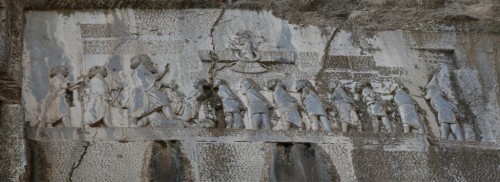
The Behistun Inscription
The Behistun Inscription of Darius the Great states that Cambyses killed his younger brother Smerdis during the early years of his reign:
Afterwards, Cambyses slew this Smerdis. When Cambyses slew Smerdis, it was not known unto the people that Smerdis was slain. Thereupon Cambyses went to Egypt.
The Greek historian Ctesias tells us that Cyrus had appointed Smerdis – known as 'Tanyoxarces' in the work of Ctesias – satrap of the eastern satrapies before his death, a position usually reserved for the crown prince. Since Cambyses had no heir, Smerdis was the next in line of succession. Cambyses may have feared his younger brother's strong position, killing him 'in secret' as the Behistun Inscription states.
CONQUEST OF EGYPT
In 525 BCE Cambyses invaded Egypt. Herodotus claims that Pharaoh Amasis II (aka Ahmose II, r. 570-526 BCE) had broken his promise to marry off his own daughter to Cambyses, sending the daughter of the former pharaoh Apries instead. This incident, however, appears to have been merely a pretext for Cambyses to subjugate the last remaining superpower of the region. Amasis himself died in November 526 BCE and was succeeded by his son Psamtik III (r. 526-525 BCE), but this did not stop Cambyses from invading Egypt. The campaign had likely been prepared years in advance.
On his way to Egypt, Cambyses marched his army along the Mediterranean coast. While passing through the Sinai desert, local Arabian chieftains supplied his army with fresh water. Cambyses also sent a Phoenician fleet with reinforcements along the Mediterranean coast. Psamtik sent his admiral Udjahorresnet (aka Wedjahor-Resne) to stop the Phoenician fleet, but Udjahorresnet apparently switched sides before any sea battle could take place. In a similar way, Polycratos of Samos, who had promised to provide Psamtik with mercenaries, decided to send these mercenaries to Cambyses instead. Psamtik was left without allies.
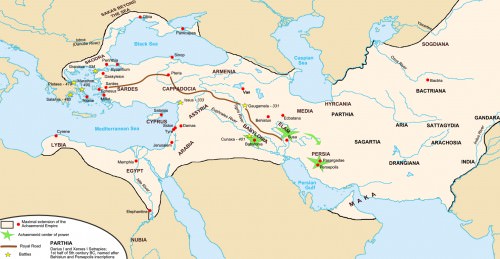
Achaemenid Empire Map
In May 525 BCE Cambyses reached the city of Pelusium, where the easternmost branch of the Nile Delta reaches the Mediterranean Sea. The Persian troops defeated the Egyptians in battle and went on to lay siege to Memphis. After the fall of Memphis, Cambyses continued to march along the Nile, and by August 525 BCE all of Egypt was in Persian hands. The neighbouring Libyan tribes and the Greek city-states along the Libyan coast voluntarily submitted to Cambyses. Upon his conquest of Egypt, Cambyses went to the Egyptian capital of Sais to have himself crowned pharaoh. He took on an Egyptian throne name and took part in Egyptian ceremonies, like his father Cyrus had done upon conquering Babylon. Admiral Udjahorresnet, who had crossed over to the Persians, was appointed chief physician and advisor to Cambyses.
Although Cambyses did not experience much trouble during his initial conquest of Egypt, the fact that he remained stationed there until 522 BCE indicates that he did face some resistance from the local population. At least one rival – Petubastis IV – challenged Cambyses' rule in 522 BCE. Petubastis likely had his residence in the Dakhla Oasis, deep in the Libyan desert.Cambyses may have sent an army to put down this revolt, and this army may have been defeated in battle. This defeat later gave rise to the legend of Cambyses' lost army, known from the work of Herodotus. In order to cover up this loss, the Persians claimed that Cambyses' army was lost in a sandstorm.
MADNESS
While contemporary sources depict Cambyses as a regular king who accommodated to the cultural and religious practices of the lands he conquered, Herodotus portrays him as a stereotypical mad king. Herodotus accuses Cambyses of defiling and burning the corpse of pharaoh Amasis and slaying a newborn Apis calf, who was worshipped as a god in Egyptian religion.In addition, Herodotus interprets Cambyses' murder of his brother Smerdis and his marriage to his sisters Roxane and Atossa as signs of his madness. Such stereotypical portrayals, however, usually arise from subjective oral traditions and should be treated with suspicion. Moreover, there are good reasons to doubt the specific claims pertaining to Cambyses' madness.

Apis Bull, Saqqara Serapeum
First of all, the notion that Cambyses slew a newborn Apis calf is contradicted by contemporary evidence. From funerary steles from the Serapeum of Saqqara, we may infer that one Apis bull died during Cambyses' reign, in September 524 BCE, but this bull was already twenty years old at the time. He was certainly not a newborn calf, as Herodotus claims, and the next Apis bull died during the reign of Darius the Great, at a mature age. Furthermore, the Egyptian priesthood may have had different reasons to hate Cambyses. Cambyses is known to have greatly curbed the privileges that had been bestowed upon the Egyptian temples by the pharaohs of the 26th Dynasty, so the story of Cambyses slaying the Apis bull may well have been invented to further damage Cambyses' reputation.
Another reason to suspect the account of Herodotus is that he places the murder of Smerdis after the invasion of Egypt and also after the slaying of the sacred Apis calf. The more or less contemporary Behistun Inscription, however, clearly states that Cambyses killed Smerdis before he went to Egypt. Herodotus, or his informer, may have taken a certain liberty in describing the order of events in order to make it appear like Cambyses' madness started after he slew the sacred Apis calf. The murder of Smerdis may indeed have been explained as a sign of madness by later Persian kings, but ultimately it was simply a strategic choice on Cambyses' part. Finally, we should not be surprised by Cambyses' marriage to his sisters Roxane and Atossa, as brother-sister marriages had been a common Elamite practice for centuries.
REVOLT OF (PSEUDO-) SMERDIS
In March 522 BCE, a man who claimed to be Cambyses' younger brother Smerdis started a rebellion in Persia. Since Cambyses had killed Smerdis 'in secret', most people knew no better than that Smerdis was still alive. The Behistun Inscription describes this event as follows:
Afterwards, there was a certain man, a Magian, Gaumâta by name, who raised a rebellion in Paišiyâuvâdâ, in a mountain called Arakadriš. On the fourteenth day of the month Viyaxana did he rebel. He lied to the people, saying: "I am Smerdis, the son of Cyrus, the brother of Cambyses."; Then were all the people in revolt, and from Cambyses they went over unto him, both Persia and Media, and the other provinces. He seized the kingdom; on the ninth day of the month Garmapada he seized the kingdom.
This narrative has been called into doubt by Albert T. Olmstead, who considers it unlikely that the murder of Smerdis went unnoticed for so many years and that a random imposter so easily took his place. Instead,
Olmstead believes that Cambyses never killed Smerdis and that the man who rose up against Cambyses in 522 BCE was, in fact, the real Smerdis. The 'imposter narrative' may have been invented by Cambyses to
delegitimize his brother's claim to the throne and was later adopted by Darius the Great to justify his coup against the legitimate successor of Cambyses.
Olmstead believes that Cambyses never killed Smerdis and that the man who rose up against Cambyses in 522 BCE was, in fact, the real Smerdis. The 'imposter narrative' may have been invented by Cambyses to
delegitimize his brother's claim to the throne and was later adopted by Darius the Great to justify his coup against the legitimate successor of Cambyses.
DEATH
Upon hearing about the revolt, Cambyses immediately gathered his army and prepared to march back home. He confessed to his army that he had killed the real Smerdis 'in secret' years before and claimed that the man
who now claimed to be Smerdis was, in fact, an imposter.
who now claimed to be Smerdis was, in fact, an imposter.
Cambyses never met Smerdis in battle. He died in April 522 BCE while he was on his way home. The Behistun Inscription states that Cambyses "died his own death" - a phrasing that has led to much speculation. Herodotus claims that Cambyses died in a Syrian town named Ecbatana after his sword slid out of his scabbard, piercing his thigh at the exact same place where he had stabbed the sacred Apis calf years before. This story seems to be derived from the same oral tradition that attributed Cambyses' madness to the slaying of the Apis bull and is therefore unreliable. Other interpretations are that Cambyses committed suicide or that he was assassinated.
Several places have been identified as Cambyses' tomb, including the Zendan-e Suleiman in Pasargadae and the Takht-e Rustam near Naqsh-e Rustam.
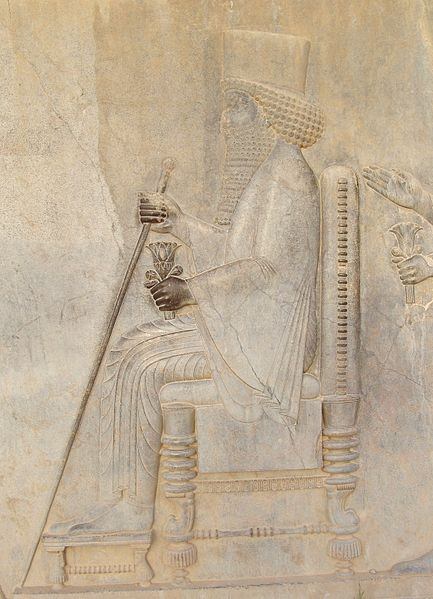
Relief of Darius I from Persepolis
LEGACY
Smerdis (either the real one or the imposter) continued to rule until September 522 BCE when he was assassinated by seven Persian noblemen. The ringleader of this conspiracy was Darius, who had been a lance-bearer to Cambyses. Now that all male descendants of Cyrus had died, Darius crowned himself king. He claimed to be a distant cousin of Cyrus and stated that the man who claimed to be Smerdis was an imposter. A civil war followed, in which Darius defeated all separatist leaders and reasserted his authority over the empire. With the rise of Darius, a different branch of the Achaemenid dynasty rose to power. Darius is known for consolidating the early Achaemenid conquests and reorganising the Achaemenid Empire.
As for Cambyses, his reputation quickly deteriorated after his death. The Persians remembered him mostly for his ignoble death, which to them was a sign that Cambyses had lost divine favour. Subsequently, all events from his reign were reinterpreted to fit this narrative. In addition, the Egyptians, who had come to resent Persian rule by the time when Herodotus was writing, had constructed a narrative of Cambyses being a mad king and a blasphemer. Looking at the contemporary evidence, however, Cambyses appears to have been a regular king who continued the policies of his father.
Tushpa › Antique Origins
Definition and Origins
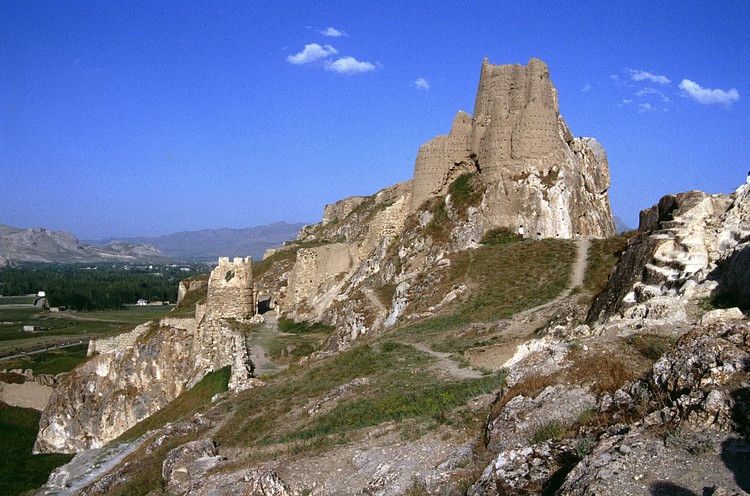
Tushpa, later known as Van, was the capital of the Urartu kingdom of ancient Armenia, eastern Turkey, and western Iran from the 9th to 6th century BCE. Located on the eastern shore of Lake Van in modern Turkey, the city was a fortress site which was reused as a provincial capital under the Achaemenian Empire and then, once again, made the capital of the Artsruni kingdom during the medieval period. Tushpa/Van is the oldest continuously inhabited city in the region.
FOUNDATION
Tushpa was founded by king Sarduri I (rc 835 - 825 BCE) around 830 BCE to function as the capital of the Urartu civilization, a loose confederation of kingdoms which covered territories in Eurasia from the Euphrates River to Lake Urmia and territory north of the Taurus Mountains. In the highlands around Lake Van, the traditional heartlands of Urartu and subsequent Armenian kingdoms, the fortress of Tushpa was built on a limestone promontory on the eastern shores of the lake. The height of the rock is in places 115 metres (375 feet). The city was named after the goddess Tushpuea (aka Tushpues or Tushpua), who was the consort of Shivini, the Urartian sun god. The name Van derives from the Urartian people's name for their region, Biaina. Tushpa/Van perhaps had a population as high as 50,000 at its peak, and it subsequently gave its name to the region: Tosp.
SIGNIFICANT CONSTRUCTION PROJECTS INCLUDE THE MASSIVE CYCLOPEAN WALLS OF FORTRESS TUSHPA.
A GARDEN CITY
Tushpa prospered thanks to the fertile plains around it, the Urartians' skills in animal husbandry, especially horse-breeding, and its location near trade routes which connected the Mediterranean with central Asia. The Urartians were also innovative and ambitious architects. Significant construction projects include the massive cyclopean walls of fortress Tushpa. With parts still standing today, the walls used huge stone blocks measuring around 6 m long and 75 cm thick. One portion of wall, perhaps originally intended as a pier or breakwater, carries an inscription in Assyrian. Carved during the reign of Sarduri I, it states:
An inscription of Sarduri, son of Lutipri, the magnificent king, the mighty king, king of the universe, king of the land of Nairi, a king having none equal to him, a shepherd to be wondered at, fearing no battle, a king who humbled those who would not submit to his authority. I, Sarduri, son of Lutipri, king of kings, received tribute from all the kings. Sarduri, son of Lutipri, says: “I procured this limestone from the city of Alniunu, I erected this wall”.(Piotrovsky, 49)
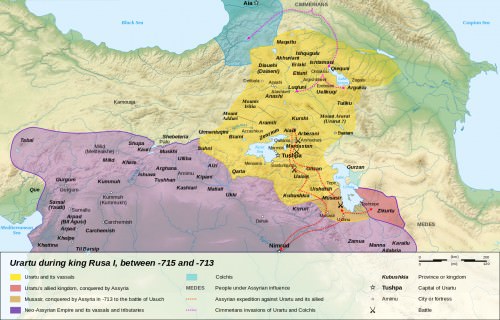
Urartu 714-715 BCE
Another great engineering achievement was the 80-kilometre long stone-lined canal which brought fresh water from the Artos mountains to the capital (Lake Van is a saltwater lake). The structure was built by king Menua (rc 810-785 BCE) and allowed the proliferation of vineyards and orchards, resulting in Tushpa gaining a reputation as a garden city. The aqueduct was raised where necessary on large stone blocks and these often carry inscriptions which name the builder and warn of a curse on any person who destroys the structure or claims it as their own work as in this example:
Whosoever damages this inscription, whosoever overturns it, whosoever does such things according to his desire or in the name of another, Menua warns that the dread god Khaldi, the god Teisheba and the sun god Shivini will efface him from the sight of the sun. (Chahin, 74)
The canal continues to function and is still used today by farmers in the region to irrigate their fields.
During Menua's reign, the city also spread around the citadel and along the shores of Lake Van, which are fertile and sheltered from the harsher extremes of the region's climate. In the reign of Argishti II (rc 714-680 BCE), a new settlement was developed on the nearby hill of Toprakkale. The site, which became the royal palace, was completed by Argishti's son and successor Rusa II (c. 680-638 BCE) when it was renamed Rusahinili.
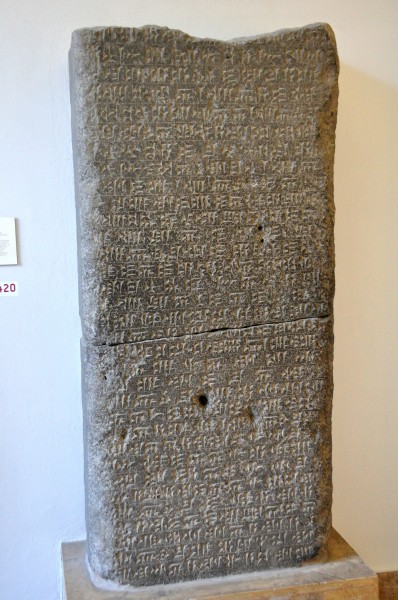
Stele of the Urartian King Rusa II
The capital had a royal necropolis composed of chambers cut into the mountain on which the city was built. Tombs are composed of single, double, or triple chambers with the tomb entrance sealed by a large stone slab. Several royal tombs, long since looted, still carry inscriptions describing the achievements of their occupant. Of those tombs discovered intact, several contain stone sarcophagi with semicircular lids. Buried with the deceased were precious goods, weapons, shields, and even furniture, a practice which suggests the Urartians believed in an afterlife and that it was similar enough to the earthly one to necessitate such provisions.
MANY CUNEIFORM INSCRIPTIONS MADE INTO THE ROCK DESCRIBE THE KINGS OF URARTU & SOME OF THEIR GREAT DEEDS.
Other surviving remains from this period include an open-air shrine with smooth walls carved out of the rock, finds of figurines such as winged goddesses who might have once adorned bronze cauldrons, fragmentary stone statuary of deities, and many cuneiform inscriptions made into the rock face which describe the kings of Urartu and some of their great deeds.
ASSYRIAN WARS
There were trade relations between Tushpa and the mighty Neo-Assyrian Empire but also major conflicts, too. Urartu did enjoy some victories in the mid-8th century BCE, but the Assyrian ruler Tiglath-Pileser III (r. 745-727 BCE) was more aggressive than his predecessors, and he laid siege to Tushpa in 736 BCE. The attack is recounted in the Assyrian annals of Tiglath-Pileser:
I shut up Sarduri [II] the Urartian in Turushpa [Tushpa], his principal city, and wrought great slaughter in front of the city gates. Then I set up the image of my majesty over against the city. (Piotrovsky, 83)
Fortunately for the Urartians, the city's walls did their job and the fortress remained impregnable. The Assyrians, nevertheless, torched and plundered the lower city, along with many others in the kingdom.
Another significant conflict between the two states was during the campaign of Sargon II (722-705 BCE) in 714 BCE, although Tushpa was not directly attacked. In the 7th century BCE, the Urartu kingdom came to a mysterious but violent end when sometime between c. 640 and c. 590 BCE their cities, including Tushpa, were destroyed. The state was probably weakened by decades of battles with the Assyrians, and it may have been too overstretched to control its own empire. The perpetrators are not known, but the Scythians are one candidate, the Cimmerians another, and even possibly forces from within the territories administered by the Urartu kings.
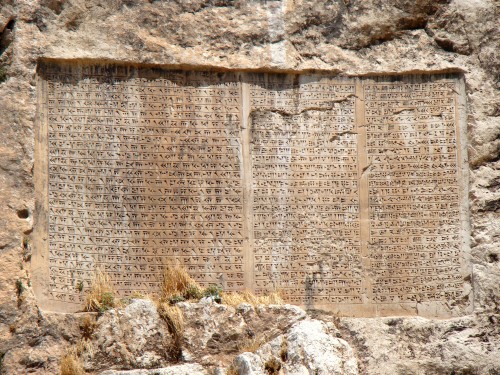
Xerxes' Inscription, Van
ACHAEMENID RULE
The territories the Urartu kingdom had once occupied were ultimately taken over by the Medes from c. 585 BCE onwards and Van was rebuilt. The region was shortly afterwards incorporated into the Achaemenian Empire of Cyrus the Great in the mid-6th century BCE. Van then became the seat of the Persian satrap who governed the new province. From this period comes the now-famous lengthy inscription on the rock face of Van. Made during the reign of Xerxes (486-465 BCE) it is written in the three official languages of the Achaemenian Empire - Old Persian, Elamite and Babylonian - and describes the king's divine right to rule over his empire:
A great god is Ormuzd, who is the greatest of gods, who created this earth, who has created that heaven, who has created mankind, who has given happiness to man, who has made Xerxes king, sole king of many kings, sole lord of many. I am Xerxes, the great king, the king of kings, the king of the provinces with many tongues, the king of this great earth far and near, son of king Darius the Achaemenian. Says Xerxes the King: Darius the king, my father, did many works, through the protection of Ormuzd, and on this hill he commanded me to make his tablet and an image; yet an inscription he did not make. Afterwards I ordered this inscription to be written. May Ormuzd, along with all the gods, protect me and my kingdom and my works. (Chahin, 69-70)
HELLENISTIC PERIOD & SASANID RULE
During the reign of the Orontid dynasty (6th-3rd century BCE), after the fall of the Persian Empire, Van was passed aside when Armavir (the former Urartian city of Argishtihinili) was made the capital c. 330 BCE. The city remained important and benefitted from the building projects of Tigranes the Great (rc 95 - c. 56 BCE) in the early part of the 1st century BCE, although he founded a new capital, Tigranocerta, in 83 BCE which was further to the west and in a more central position within the newly expanded Armenian Kingdom.
When the Arsacid dynasty ruled Armenia (12-428 CE) Artaxata was the capital but Van remained important in the region. The city's continued importance as a trading centre resulted in it acquiring a more cosmopolitan population; the Jewish community was especially large. When the Sasanid king Shapur II (r. 308-379 CE) invaded Armenia in 368-9 CE, Van was one of the cities attacked and its whole population was forcibly relocated to Persia.
LATER HISTORY
Van did rise again to prominence during the medieval period when it was made the capital of the Artsruni (Ardsruni) kingdom which sprang up in Armenia from the late 8th century CE. The Artsruni prince Gagik, ruling under the auspices of the Abbasid Caliphate, made Van his capital in 908 CE. Yet again, the city was replaced as the royal residence, this time by Aghtamar, located on an island on Lake Van, but Van remained a thriving cultural centre if not a political one. Successively ruled by the Byzantines and Seljuk Turks, Van was sacked and destroyed in 1387 CE by Timur Leng, the Turco-Mongol conqueror (r. 1370-1405 CE) who then hurled 7,000 captives over the citadel's walls to their deaths. The city drifts into obscurity from then until the Ottoman period and a return to regional importance in the 19th century CE when it became a centre for Armenian rebellion against Turkish rule.
This article was made possible with generous support from the National Association for Armenian Studies and Researchand the Knights of Vartan Fund for Armenian Studies.
LICENSE:
Article based on information obtained from these sources:with permission from the Website Ancient History Encyclopedia
Content is available under License Creative Commons: Attribution-NonCommercial-ShareAlike 3.0 Unported. CC-BY-NC-SA License